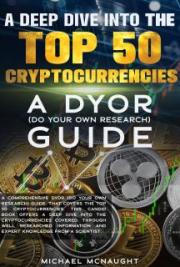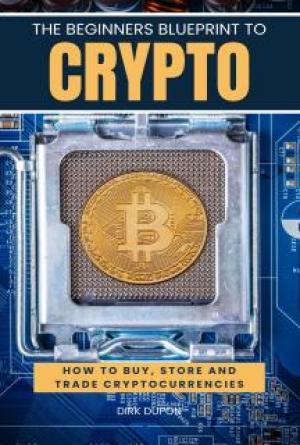CRYPTOCURRENCY
A quick guide to understanding cryptocurrency
Kynchin Rivera
BY
Text Copyright
©2018 by Kynchin Rivera
All rights and reserved.
All rights and reserved.
This book or any portion thereof may not be reproduced or used in any manner.
Whatsoever without the express written permission of the publisher except for the
use of brief quotations in a book review.
Disclaimer Notice
Please perform the information contained in this book at your own risk.
Table of Contents
Introduction
Chapter 1
Cryptocurrency………………………………………………………………………….……2
What is Mining in Cryptocurrency?...........................................................3
Best Wallets to Try......................................................................................5
Chapter 2
Kinds of Cryptocurrencies………………………………………………………………..6
Chapter 3
Why Growing Numbers of People Invest In Cryptocurrency?.................13
Advantages and Disadvantages.…………….…………………………………………13
Best Cryptocurrency to Invest……………….…………………………………………15
Chapter 4
How Digital Currency Works in Our Daily Life?......................................16
Can it change our lives?.............................................................................16
Characteristic of Cryptocurrency..............................................................17
Chapter 5
The Future of Cryptocurrency…………………………………………….……………19
What is Blockchain?.................................................................................20
Introduction
Technology has come-up into a new level – from digital phones, tablets,
computers, and now the Digital Currency or known as the Cryptocurrency
of the new generation. Many people use debit and credit cards instead of
a physical money coming from their pocket wallets to pay for their
purchases, but there is more than a card to pay for your commodities at
this millennium, and it is actually the ‘Cryptocurrency’. Not everyone
know what cryptocurrency is, some even think that this is a scam, some
people think it’s not true until they know how is it done.
There are many types of cryptocurrency, the Bitcoin or BTC is the most
popular specially for beginners. Next to bitcoin is the Ethereum, Litecoin,
Ripple, Dash, IOTA, Monero, Zcash, Cardano, Stellar, NEM, NEO and
Tron. The said cryptocurrencies have their sorts of similarities and
differences, when it comes to uses, trading, and policies. Japan has
officially open its door for digital currencies as a mean of payment right
next to real money. Japan and South Korea drives a high traffic of
cryptocurrency exchanges according to CoinMarketCap, in fact South
Korea is making major improvements as of 2017 for more safety
transactions in the Bitcoin World.
Some says that cryptocurrencies tend to be bad because of their bubble
like characteristic. There are also people who find it very useful, in fact,
some make money from it while in the four corners of their houses. There
are lots of merchandisers and big companies that are now accepting
virtual money as a form of payment for every purchase done. Booking
flight and buying software online is also covered by virtual money, you can
now book flights and purchase software from Microsoft using Bitcoins
with hassle free transaction.
1
Chapter 1
Cryptocurrency
Cryptocurrency is a virtual currency that uses cryptography to secure
every transaction made, thus counterfeiting this kind of currency is very
impossible to do because of this security feature. The invention of the so
called digital currency is not really intended by Satoshi Nakamoto the
inventor of Bitcoin, which is the first cryptocurrency. In 2008, Nakamoto
said that he has developed a “Peer-to-Peer Electronic Cash System,” and
announced the first release of Bitcoin in 2009, which is an electronic cash
system that prevents double-spending. Bitcoin is completely
decentralized with no central authority or server.
The first cryptocurrency to run online as a virtual is Bitcoin – launched in
the year 2009 under the pseudonym Satoshi Nakamoto. As of February 6,
2016 there is about 15.2 million Bitcoins circulating in the world.
Cryptocurrency is just like a real physical money, you can keep it, spend
it, and even do an investment with it. However, cryptocurrency can be
wiped out by a system crash if a back-up copy doesn’t exist, since it is a
virtual money and it doesn’t have any central repository. Cryptocurrencies
are designed to decrease the production of money – The first
cryptocurrency Bitcoin has an ultimate cap of 21 million BTC in total.
Mean to say, there are only 21 million Bitcoins can be mined, once the
Bitcoin miners unlock this total number of BTC the supply will be totally
tapped.
Having on hand a digital money requires ‘Mining’, while others uses to
trade theirs. People behind this gigantic invention still remains a secret,
no one knows who is Satoshi Nakamoto is – can’t even figure out if it’s a
group or a single individual behind it
2
What is Mining in Cryptocurrency?
As a beginner, maybe you’re being confused of the word ‘Mining’, well to
explain this in a very simple way try to imagine golds and how they are
being mined. But before you think of buying a physical shovel and
mattock, let me explain how mining is done virtually. Crytocurrencies like
Bitcoin are mined with the use of computers. Mining requires specialized
computerswhich can find solutions to difficult math problems in order to
add a new block into the blockchain. Anyone who has access to the
internet with the right equipment’s can participate to mining and earn
bitcoin rewards.
Mining is not that easy, but it depends on how much effort you are putting
in your network. To start mining bitcoins, you need to have the all
necessary equipment’s for a more effective and successful mining process.
Things you need:
1. Get a Mining Rig- Mining rig can be costly, some chooses to
customize their own, while others often make investment of buying
the best rig to use.
2. Bitcoin Wallet- You can consider this one as an online wallet
where you can store your bitcoins etc... safely. Once you’ve signed
up for a wallet, make sure to get your wallet address – you can see it
as a long sequence of numbers and letters. In keeping your coins,
you must copy your wallet address on a sheet of paper or you can
use some storage device as your back-up in case your computer
crashes. So why you have to do this? It’s just simply because when
3
your computer crashes all your bitcoins will disappear and they will
be gone forever unless you know your wallet address.
3. Find a Mining Pool- Mining pool is a group of miners that
combines their computing powers to get more Bitcoins. Joining a
pool will give an easier and smaller algorithm to solve. But before
deciding to join a pool you have to considered few things first, and
these questions must be answered clearly.
What is the reward method in the pool?
How stable is the pool?
What are the fees and charges for withdrawal?
How easy is withdrawing funds?
How frequent they find a block?
4. Mining Program- Choose a software depending on the equipment
you are using – when GPUs and FPGAs you must use a host
computer running these two; the standard bitcoin wallet, and the
mining software. Consider also the OS (Operating System) you are
using, for Windows the best software would be the Bitcoin Miner
and BTCMiner, for Linux you can try CG Miner BFG Miner and
EasyMiner, and if you’re using Mac OS, RPC Miner is the best for
you.
The mining software will the one to instruct the hardware to do the
work of mining.
4
5. Start Mining- All is set and you need to start the mining process,
connect your miner and power up – to start you need to put the
mining pool, username, and password. Once configured you can
now mine your first bitcoin reward.
Best Wallets to Try
1. Coinbase- This online wallet was founded by Brian Armstrong and
Fred Ehrsam in the year 2011. The company launched buy and sell
bitcoin services in October 2013 This application operates
exchanges of cryptocurrencies such as Bitcoin, Ethereum, Litecoin
and Bitcoin Cash. This cryptocurrency has already assisted 10
million customers, and transacts worth $50 billion worth of digital
currency exchanges so far according to their site.
2. Electrum- This is one of the most popular Bitcoin wallet online. It
is beneficial to both beginners and experts – Electrum focuses on
speed and simplicity using low resource of usage. This electronic
wallet can handle complicated parts of Bitcoin system by the use of
remote servers. If ever you lose the wallet online during a computer
crash, you can easily recover the wallet using a secret phrase.
3. Trezor- Trezor is the first hardware wallet in the market, and the
first to implement the passphrase feature. The passphrase feature
secures the funds and if ever the owner loss the device. Trezor is an
small device designed to protect private keys from possible hacking
online.
5
4. Nano Ledger S- This wallet support almost all the popular
cryptocurrencies and allow you to store. It has an special feature that
can store 2 kinds of currency at the same time in the same wallet,
unlike others that allows only one.
Chapter 2
Kinds of Cryptocurrency
Since bitcoin have been introduced, hundreds of cryptocurrencies enter
the market. Many alternative cryptocurrencies or altcoins have been
launched – following the success of Bitcoin, and they have grown into 700
in number. Some are being sold cheaper than Bitcoin, while some tend to
be more accessible than Bitcoin. In this section of the book – 12 of the
most popular cryptocurrencies will be told. Maybe you already heard
about Bitcoin and have some mysterious things on how it works, but this
time you will be entering the world of cryptocurrency and understand
what are the playful currencies inside cryptocurrency.
1. Bitcoin
Bitcoin is the first and most popular cryptocurrency in the world,
some are not aware of its existence but it actually stands as a
worldwide payment system. Bitcoin has no bank; in fact, it is based
on mathematical proofs. Just like the technology of E-mail, no one
owns nor control the system of Bitcoin. Even the group and person
behind it still remain a secret, only the pseudonym Satoshi
Nakamoto is has been introduced to public.
6
To have a Bitcoin on hand you have to sign up for an online wallet
first. Yes, a virtual wallet for a virtual money, there are sorts of
online wallets you can sign-up for and they’re all free to use. Next is
to buy a bitcoin directly from other people using marketplaces
online, but you can also use digital currency exchanger like
Coinbase, Kraken, Bitstamp, CEX.IO and BitFinex. Most exchanger
requires to connect any of your cards or bank accounts to make a
purchase. You can now go to the exchange’s buy section and select
the amount of bitcoin you want to buy. Bitcoin changes its value
from time to time, it can increase or decrease value – no one knows.
Bitcoin has a public ledger called ‘Blockchain’, which serves as a
record for every Bitcoin transaction. The blockchain has a growing
list records called blocks that is secured by cryptography, once the
block has been recorded they can’t be altered anymore.
Bitcoin can be used in purchasing goods, sending money, travel
booking online, and buying digital products – by this, transactions
are made with no middle man, meaning no banks involved at all.
2. Ethereum
In 2011 a programmer named Vitalik Buterin from Toronto first
grew interest on Bitcoin. Buterin, 19-year-old at that time have co-
dounded the online news website Bitcoin Magazine, and wrote
hundreds of articles about cryptocurrency world. In the year 2013
Buterin have released the white paper. Which describes an
alternative platform designed for any decentralized application a
developer wants to build. The system was then called Ethereum, just
like Bitcoin, Ethereum is also a distributed public blockchain
network. Though there are some technical differences between the
7
two cryptocurrency, because in Ethereum, miners work to earn
Ether instead of mining. Ether is a piece of code that allows the
program or application to run – no one owns Ethereum, but its
system supporting its function isn’t free. Unlike Bitcoin, Ether
doesn’t have a cap limit, in fact, 13 million Ether are mined per year.
In order to buy an Ether, you need to find online or a person who
has it and at the same time wants to trade it for cash. There is also
another option if you want to have an Ether on hand, some try to
purchase a bitcoin first from trusted bitcoin exchangers then trade
it for Ethereum.
3. Litecoin
This cryptocurrency is also generated by mining; it was created by
Google’s former engineer Charles Lee in October 2011. Litecoin is
created to enhance the speed of mining from the opposed time 10
minutes to 2.5 minutes when generating a block. The said online
currency has faster transaction than bitcoin because it uses “scrypt
algorithm”, which favors large amount of high-speed RAM that’s
why scrypt is being called as the ‘memory hard problem’. Just like
Bitcoin, the Litecoin has also its limit of 84 million coins and a
market cap of $540, 274,528.26.
Litecoin can handle high volume of transactions
Reduces double-spending attack
Fast confirmation especially for merchants
8
4. Ripple
What is Ripple? Is Ripple same as Bitcoin? Well, it’s a big NO. Ripple
is a currency exchange and remittance network that uses a common
ledger managed by a network and is validated by independent
servers. The Ripple Labs, a global money transaction firm which is
former OpenCoin, was co-founded by CEO Chris Larsen and CTO
Jed McCaleb who is well-grounded in digital currency. Jed McCaleb
is currently handling the majority Bitcoin trades in the world. While
Larsen used to be the co-founder of the financial company E-LOAN
– the rest of the Ripple developers also have a background in
Bitcoin. Ripple is based on shared public database – a big difference
with Bitcoin that is generated by energy and computing intensive
proof of work. Ripple is doesn’t use the blockchain technology, the
companies goal is to keep the money flowing freely.
5. Dash
Dash was first launched as Xcoin, then changed its name into
Darkcoin, and in 2015 the Darkcoin has been rebranded into Dash,
which is now the 6th biggest cryptocurrency in the world. Dash is a
peer-to-peer cryptocurrency that was forked out from Bitcoin
engaging to a faster and more private transactions. Dash is the first
to have a decentralized blockchain governance system, just like
many cryptocurrencies Dash is also trying to solve some of the
Bitcoin’s inconveniences. It provides faster transactions and more
anonymous service to its users. Dash transactions are made within
4 seconds, far from the transaction process of Bitcoin which usually
takes 10 minutes to finish. Dash is also earned by mining, just like
Bitcoin.
9
6. Monero
Monero is a cryptocurrency that has the most anonymity when it
come to their transactions made. It is a secure and untraceable
currency system that uses special kind of cryptography for a 100%
unlikeable transaction. The Monero receives high-level of
popularity due to its privacy oriented features after it was launched
in 2014. The mining process used by Monero is based on Egalitarian
concept.
7. IOTA
The cryptocurrency IOTA is very much different from majority
online currencies – it’s designed for machine but can’t be mined.
IOTA stands for ‘Internet of Things Application, it addresses the
scalability issues of blockchain and the transaction fees at the same
time by getting rid of the block and chain. The mechanics is to
simply verify two previous transactions, in order to submit it to the
IOTA ledger. The total supply of this coins are fixed into
2,779,530,283,277,761 coins. Miners doesn’t have to power-up the
network and there is no central ledger for this cryptocurrency.
8. Zcash
Zcashis launched by Roger Ver, Barry Seibert, and the Pantera
Capital in October 28 2016.Zcash is a decentralized and open-source
cryptocurrency, it uses a special secured network called ‘zk-snark’.
This special feature allows the network to maintain and secure the
ledger without disclosing the amounts in every transaction.
10
9. Stellar
Jed McCaleb the co-founder of Ripple is the founder of this Stellar
Cryptocurrency, which is also a payment technology. Stellar is
almost the same as the other payment technologies – a
decentralized server runs the network with a distributed ledger the
is updated every 2-5 seconds. It does not only depend on miners,
instead it uses Federated Byzantine Agreement (FBA) Algorithm,
which helps for a faster transaction.
10.
NEM
NEM is launched in March 31,2015 as a peer-to-peer cryptocurrency
and blockchain platform, written in Java and C++ programing
language. NEM stands for ‘New Economy Movement’, unlike most
cryptocurrencies NEM have its own consensus algorithm. This can
prevent attacks against the network and all the trasnactions made.
NEM aims to create a smart asset blockchain, which can perform
heavy workloads.
11.
NEO
NEO is the first decentralized and opensource cryptocurrency in
China, which was founded by Da Hongfei. Neo is a cryptocurrency
and blockchain platform at the same time, it was launched in 2014
as ‘Antshares’ and debranbed last June 2017 as ‘NEO’. Neo can
support 10,000 transactions per second – using the Byzantine Fault
Tolerance (Dbft) consensus mechanism.
12.
TRON
This cryptocurrency was first introduce in September 9, 2017, and
was founded by the TRON Foundation – a non-profit organization
11
from Singapore. Tron is also a decentralized open-sourced
cryptocurrency, but has a feature of an application. Tron’s
technology is a storage facility that allows users access content in
every part of the world, without any assistance from Google Play
Store. It also allows content creators to earn from sharing their
content.
13.
Steem
Steem is a blockchain-based social media platform where you can
earn rewards. It was launched in July 2016 and currently has 70,000
users, from then Steemit has grown considerably. Steem is very
much different than the other cryptocurrencies, it has a built-in
inflation of 100% annually without any coin limit. Steem supports
online communities and even social media platforms by giving
rewards through virtual currency.
12
Chapter 3
Why Growing Numbers People Invest in
Cryptocurrency?
Nowadays many people are deciding to invest with







